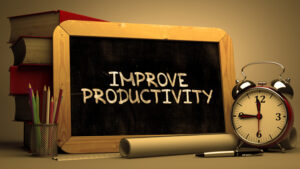In knowledge work, being productive is all about making the right decision and then taking effective action. Here are nine tricks for improving productivity through better concentration, collaboration.
You’ll never guess one reason U.S. President Barack Obama cites for why he’s so productive at work.
Because he wears only blue or gray suits.
Sounds crazy, right?
But it actually makes sense. Even something as innocuous as a clothing choice takes up mental capacity that could be better spent on weightier decisions. By avoiding excessive wardrobe choices, the president seeks to minimize his decision making workload, which in turn allows him to get more done.
It’s an interesting strategy, and it that got me wondering what similar tricks we as knowledge workers could employ to make us more productive in our jobs. It comes at a critical time, too, with productivity growth in developed countries on a seemingly continuous downward spiral.
Concentrate!
For knowledge workers like us, productivity begins with transforming data into knowledge, which requires that we diligently focus our attention and energy on the task at hand. That’s often easier said than done.
Our offices, even our home offices, are packed with interruptions, and those distractions that can prevent us from crossing even the easiest tasks off our to-do list. Here are three ways to help achieve concentration mode:
1. Request “Privacy please!”
Don’t just assume people know you’re busy or need to concentrate; tell them. You’re rarely interrupted if your colleagues truly understand that you’re under pressure to perform.
2. Do it electronically, too
In the electronic version of the above, notify your colleagues that you’re busy by putting your status indicator of your UC client on “do not disturb” or turn on your auto-reply.
3. Treat the phone like a hot potato
Don’t feel compelled to answer a ringing phone when you’re busy – mute it. Let the caller leave a message and deal with the issue when you finish with your task or need a break from concentrating.
Collaborate!
Once we’ve turned data into knowledge, we need to act on it. This involves collaborating with coworkers, business partners, vendors and others. Unfortunately, many of us instinctively try to achieve this by setting up just another meeting, when in fact productive collaboration requires a little more finesse.
Here are three suggestions for improving collaboration:
4. Think before you punch the “Set Up a Meeting” button
Collaboration doesn’t always require a meeting. Ask yourself: Does this issue absolutely require a meeting? You may find that you can accomplish the goal with a few phone calls or an instant message or two.
5. Save “the more the merrier” for parties
If you do need to meet, ask: Which people absolutely need to be there? Invite only those whose presence is vital to resolving the issue at hand.
6. Set clear expectations
In your meeting invitation clearly explain why you’re requesting the meeting, why the attendee’s presence is needed and what you intend to accomplish. Invite attendees to opt out if they don’t feel they can contribute.
Decide!
Decision making in a collaborative environment is all about assembling the right people with the right blend of knowledge and experience to arrive at the best decision possible.
While entire books have been written about the art of making good decisions, here are three simple and easy-to-use suggestions.
7. Encourage disagreement
Group leaders must encourage team members to express a diversity of perspectives, especially respectful, principled dissent. Be sure to use a “devil’s advocate” approach when scrutinizing each option you’re studying.
8. Stay focused on the problem
Decision making goes awry when the team becomes distracted and loses sight of the problem, which occurs often. As you deliberate, continually reflect on the issue at hand and refocus if you begin to stray off course.
9. Keep your mouth closed and ears open
Input from every meeting attendee is vital to evaluating the issue from all perspectives and making an informed decision. Group leaders should devote at least 80% of their time to listening and observing and just 20% to speaking.
While our job duties are undoubtedly different than those of the U.S. president, we can take a lesson from him in finding new ways to increase our productivity.
Author: Guest Author
Published On: 3rd Jan 2017 - Last modified: 11th Apr 2017
Read more about - Archived Content, Jabra








